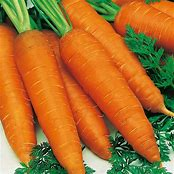What to plant in July….
- artvs3
- Jul 1, 2025
- 4 min read
July is a great month for sowing seeds, as both air and soil temperatures are high. The long, warm days with good light levels speed up the germination process, but the water table is lower at this time of year and so extra watering may be needed. Carrots can be sown now for an Autumn crop.
Home-grown carrots have plenty of flavour, and there's a much wider variety of carrots to grow at home than anything you can buy in the shops. As well as the standard orange carrot, you can also grow purple, yellow and white carrots, along with rounded carrots that are best suited to growing in pots.
Good soil preparation is essential. Fork it thoroughly to break up lumps and remove as many stones as possible. Carrots thrive in light, well-drained but moisture-retentive soil, but can 'fork' if the nutrient value of the soil is too high. For this reason it's best to not add organic matter to the soil the year you use it for growing carrots – add organic matter the year before, instead.
Make a seed drill (shallow trench) about 1cm deep using the edge of a hoe or trowel. Sow the seeds thinly along the bottom of the drill about 5-8cm apart with 30cm between rows. Be careful not to grow carrots too close together as this can stunt their growth, and it's best to avoid thinning carrots to avoid carrot root fly.

Carrot root flies will detect the smell of crushed foliage when you pull carrot seedlings up, and lay their eggs in the soil around the carrot plants. The larvae then burrow into the carrot roots, eating and defecating in them. Resistant carrot varieties are available, but alternatively, you can place a 45cm-high fine-mesh barrier around crops or cover them with fleece or a similar material. Alternating a row of carrots with a row of companion plants like onions or garlic may help to mask their smell and keep carrot flies away.

If you want to grow your carrots in a pot rather than in the ground, your pot needs to be at least 30cm deep and you must harvest longer varieties early, before they reach the bottom of the pot.
Otherwise, carrots don’t require too much care. Aim to keep the soil around them weed free, although once the they start to grow strongly, their foliage will shade out most weeds. Water occasionally – you want the roots to grow long so too much watering will result in stunted growth, because the roots will get everything they need near the soil's surface.
Carrot seeds should germinate within a couple of weeks but can take up to three months to grow – depending on the variety you choose. You should be harvesting fresh carrots around 10-16 weeks after sowing.

To prevent your crop from bolting, grow in a spot that doesn't get full sunshine during the heat of the day. Carrots that are flowering are a sign that the crop has bolted, often because of unseasonably warm weather. You can either leave the flower to provide food for bees and other pollinators or remove the plant from your row, but the carrot will no longer be edible once the plant has flowered.
To harvest your carrots it’s best to lift carrots when the soil is moist, or water beforehand, so they don't break apart when you pull them. Water the soil again to settle it around the remaining roots.

Storing carrots is a great way to deal with gluts and ensure you can enjoy fresh carrots throughout winter. On well-drained soils, carrots can be left in the ground, protected from frost by a thick layer of straw, bracken or soil. On wetter soils, the ground can become hard in winter, which makes harvesting difficult, so it's better to make a clamp.
A 'clamp' is made using horticultural sand and straw, and is the best way to store carrots. It protects the crop from frost in the same way soil does, but holds less water than soil, making harvesting easier. By making a clamp in autumn you can keep carrots fresh until early spring.
Choose a sheltered, dry site to make your clamp, and use carrots in good condition. Prepare your crop by shaking off loose soil and removing any foliage.
Use a spade to dig a shallow hole about 15cm deep and pour a 5cm layer of horticultural sand over the bottom. Lay out your carrots and then cover them with a second layer of sand, so you can no longer see any carrots
Cover the sand with straw and then cover the straw with soil
If you have a lot of carrots to store, you can make a larger clamp. Start by digging a circular hole then adding a layer of sand to the bottom. Create a ring of tightly-packed carrots, about a metre in diameter, with their necks facing outwards. Continue adding carrots to create a pyramid shape. Then add a 30cm layer of clean straw over the clamp. In cold areas, add a layer of soil for extra frost protection. Cover with plastic sheeting

There's a huge variety of carrots to choose from, with rounded, short and long roots to suit your growing space. Carrots are mostly available to buy as seeds but some companies also offer plug plants during the growing season. You can choose a mix of early and maincrop varieties to extend your season of cropping.
Here are some examples:
'Amsterdam Forcing 3' – produces short, cylindrical roots

'Autumn King 2' – classic orange, late-maturing variety

'Nantes' – sweet, perfect for slicing

'Parmex' – a round-rooted carrot, perfect for growing in pots

'Purple Haze' – dark purple skin surrounds the orange flesh

'Resistafly' – resistant to carrot fly

.png)



Comments